
How to Select the Best Box and Pan Brake Machine for Your Specific Applications
- By:Metmac
- 2024-09-10
- 163
Introduction
Sheet metal fabrication is a crucial process in various industries, requiring specialized machinery like box and pan brake machines. These machines enable precise bending of sheet metal into intricate shapes, allowing manufacturers to create a wide range of products. However, selecting the right box and pan brake machine for your specific applications can be daunting, considering the diverse models and features available. This article will guide you through the key factors to consider when making an informed decision.
Capacity and Throat Depth
The capacity of a box and pan brake machine refers to the maximum thickness and width of metal it can bend. Choose a machine with a capacity that aligns with your expected workload. The throat depth determines the maximum distance between the bending beam and the edge of the table, influencing the size of the bends you can make.
Type of Bending
Different types of bends require specific tooling. Identify your bending requirements (e.g., V-bending, edge bending, channel forming) and select a machine with the appropriate tooling. Some machines offer interchangeable tools, providing versatility for various bending tasks.
Control System
The control system determines the machine’s ease of use and precision. Choose between manual, semi-automatic, or fully automatic control systems. Manual controls provide direct operator involvement, while semi-automatic systems reduce setup time and improve accuracy. Fully automatic machines offer the highest level of precision and repeatability.
Materials Compatibility
Consider the types of materials you will be bending. Some machines are suitable for a wider range of materials, such as mild steel, stainless steel, aluminum, and copper. Others may be designed for specific materials, such as high-strength alloys.
Speed and Efficiency
Speed and efficiency are essential factors for high-volume production. Look for machines with fast cycle times and automated features that minimize setup and handling time. Consider the machine’s ability to handle various bend angles and shapes, reducing the need for tool changes.
Safety Features
Safety is paramount in any machinery operation. Ensure the machine complies with relevant safety standards and incorporates features such as overload protection, emergency stops, and guarding systems to protect operators.
Support and Maintenance
Choose a manufacturer with a proven track record of providing reliable support and maintenance services. Access to spare parts, technical assistance, and regular maintenance can ensure the machine’s optimal performance and longevity.
Selecting the best box and pan brake machine for your specific applications involves carefully considering the factors discussed above. By evaluating your bending requirements, capacity needs, control preferences, material compatibility, speed, safety concerns, and post-sales support, you can make an informed decision that will optimize your sheet metal fabrication process, enhance productivity, and meet your business objectives.
-
Metal Sheet Forming Machine: The Engine of Modern Fabrication and the METMAC Standard
2025/12/30 -
Laser Cutting Machine for Steel Plate: Precision Redefined for Modern Fabrication
2025/12/30 -
Metal Curving Machine: Shaping Strength with Precision and the Art of METMAC Engineering
2025/12/30 -
Shear Metal Cutting Machine: Precision, Power, and the METMAC Standard
2025/12/30
-
Advanced Sheet Metal Rolling, Laser Cutting, and Folding Machines for Precision Fabrication
2025/10/31 -
High-Performance Sheet Metal Bending and Cutting Machines for Modern Fabrication
2025/10/31 -
High-Quality Sheet Metal Equipment for Sale: Efficient Solutions for Modern Manufacturing
2025/10/31 -
High-Performance Sheet Metal Equipment for Sale: Forming and Shearing Solutions for Modern Fabrication
2025/10/22
-
A Guide to the Latest Innovations in Sheet Metal Folding Machines
2024/11/29 -
Key Features to Consider When Investing in a Sheet Metal Folding Machine
2024/11/28 -
Enhancing Precision with Advanced Sheet Metal Folding Machines
2024/11/27 -
How to Choose the Right Sheet Metal Folding Machine for Your Workshop
2024/11/26







